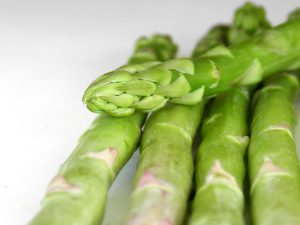Dunk 'em, Dip 'em, Enjoy those veggies
Did you know that eating vegetables with dip could help your kids eat more vegetables? A recent study from the Academy of Nutrition and Dietetics found that kids ate 80% more broccoli when it was served with ranch dressing as a dip. Other healthy dips you can try with your child include salsa, yogurt, hummus or peanut butter. You can also try the unique and tasty dip recipes below with your child:
Creamy Pesto Dip
Ingredients:
- 1 cup cottage cheese
- 2 Tbsp pesto (find a quick pesto recipe here

Directions: Combine ingredients in a blender or food processor, blend until smooth and creamy.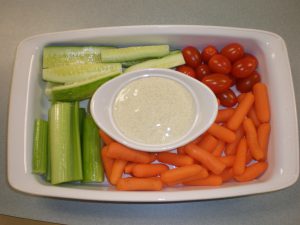
Serve chilled alongside your favorite vegetables.
Honey Mustard Hummus
Ingredients:
- 1-15oz can white cannellini beans, drained and rinsed
- 1/4 cup yellow mustard
- 1/4 cup honey
- 1/2 tsp garlic powder
- Salt and Pepper to taste
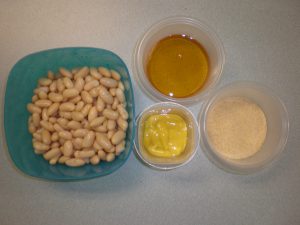
Directions: Combine ingredients in a blender or food processor, blend until smooth and creamy.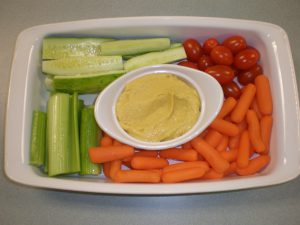
Serve chilled alongside your favorite vegetables!
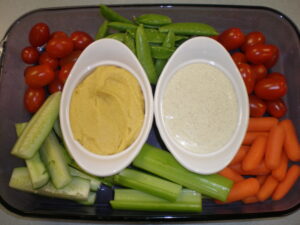
*Store pesto sauce in airtight container in refrigerator for up to one week. Pesto freezes well. Freeze in ice cube trays, and then store frozen pesto cubes in plastic freezer bags in freezer for up to 6 months. Pesto may also be frozen in small jars or plastic containers for up to 9-12 months.
Recipes from Super Healthy Kids www.superhealthykids.com
Submitted by Amber Porter, graduate student with EFNEP, located at NC A&T State University.
Enjoy the weather and play outside with your children
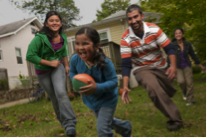
When I was a child, we played outside all the time. We just knew we had to be home by the time the streetlamps came on or we were in big trouble! We rode our bikes all over the neighborhood, playing cops and robbers, watching the train flatten our pennies on the railroad tracks and simply having fun with minimal supervision.
Today, it’s a different world, but our children still need to play outside. Playing outside enables children to use their imagination and use those little gray cells in their brain and exercise the muscles in their body rather than being passively entertained by video games. Spend time outdoors with your children teaching them some of the fun low-tech games you played as a child. Remember Red Rover, Mother May I, Dodge Ball, Freeze Tag, jump rope, hopscotch, Hide and Seek, Simon Says? Other great outdoor activities that you can do with your children include roller skating, horseback riding, fishing, flying a kite, swimming, and hiking.
If you still want to incorporate some technology in your outdoor fun check out geocaching. Geocaching is a real-world, outdoor treasure hunting game using GPS-enabled devices. Participants navigate to a specific set of GPS coordinates and then attempt to find the geocache (container) hidden at that location. Check it out at www.geocaching.com. Whatever you choose, choose to play outdoors with your whole family.
Share with us some of your favorite things to do with your family outdoors.
Oven-Roasted Asparagus
- 1 1/2 pounds fresh asparagus
- 1 tablespoon olive oil
- 1 teaspoon chopped garlic or a pinch of garlic salt
- 1/4 teaspoon pepper
- 1/4 cup grated Parmesan cheese (optional)
- Slivered almonds (optional)
Preparation
- Thoroughly rinse asparagus.
- Snap off and discard tough ends of asparagus.
- Place asparagus in a bowl and drizzle evenly with olive oil.
- Sprinkle asparagus with garlic (or garlic salt) and pepper. Gently toss to coat.
- Spread asparagus evenly on cookie sheet.
- Bake at 350° for 8 to 10 minutes, or to desired degree of tenderness. Transfer asparagus to a serving dish; sprinkle with Parmesan cheese and/or slivered almonds.
Enjoy!
Enjoy strawberries this season!
In need of a healthy spring and summer snack idea? Try strawberries!
Oven-Dried Strawberries
Strawberry time is here! They’re on sale everywhere and ready to be picked in the fields in many areas. If you buy too many strawberries to eat before they go bad, try drying them out in the oven. They smell delicious and taste even better.
Strawberries are super easy to oven dry as long as you have time. The prep time is about 5 minutes, and the total oven drying time is about 3-4 hours.
Here are the directions for oven drying strawberries:
- Line your baking sheet with parchment paper.
- Slice strawberries in half, or in thirds or even quarters if they are big berries. Remove the white part that’s inside the berries (usually in larger ones) and lay them cut side up on a baking tray. Place your baking tray in a low oven. 200 degrees F or as low as your oven goes.
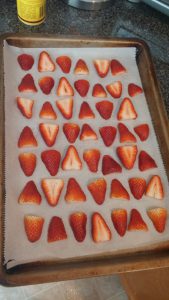
- Depending on how large your strawberries are and how dry you want them, the strawberries will take between 3-4 hours to dry. Turn the berries over after about 1 1/2 hours so that the seedy side is up.
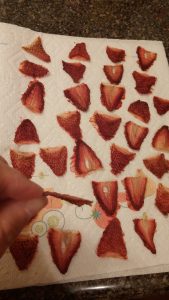
- Peel the dried strawberries off the parchment paper, and store them in an air tight container.
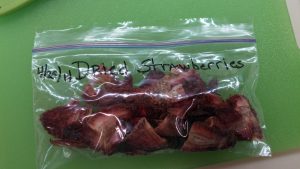
Enjoy!
